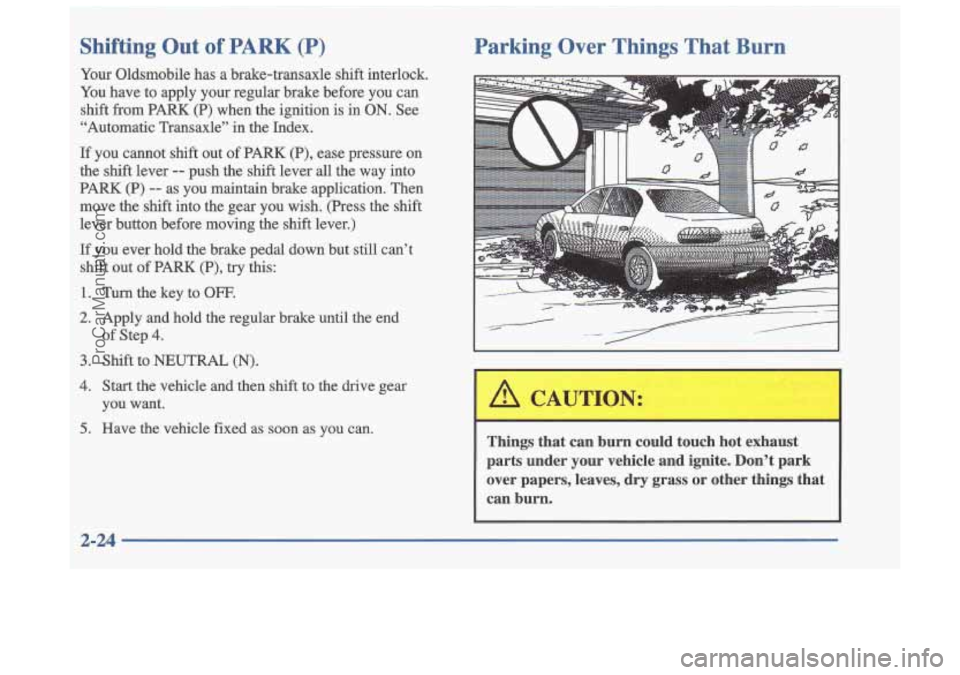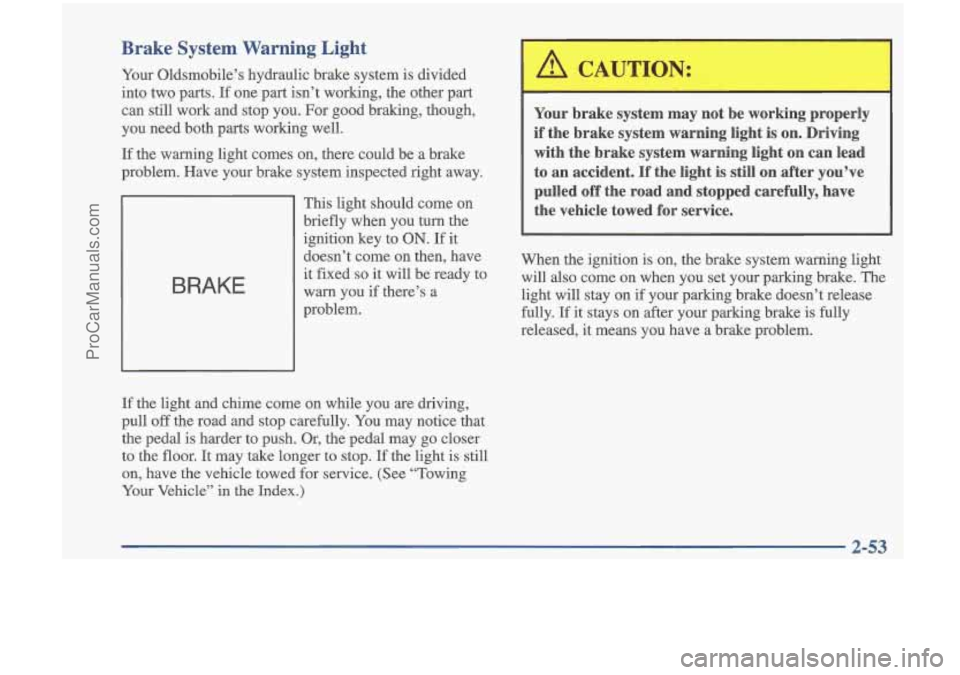Page 81 of 353

Shifting Out of PARK (P)
Your Oldsmobile has a brake-transaxle shift interlock.
You have to apply your regular brake before you can
shift from PARK
(P) when the ignition is in ON. See
“Automatic Transaxle” in the Index.
If you cannot shift out of PARK (P), ease pressure on
the shift lever -- push the shift lever all the way into
PARK (P)
-- as you maintain brake application. Then
move the shift into the gear you wish. (Press the shift
lever button before moving the shift lever.)
If you ever hold the brake pedal down but still can’t
Shift QUt
Of PARK (P) , try this
1.
2.
3.
4.
5.
Turn the key to OFF.
Apply and hold the regular brake until the end
of Step
4.
Shift to NEUTRAL (N).
Start the vehicle and then shift to the drive gear
you want.
Have the vehicle fixed as soon as you can.
Parking Over Things That Burn
1 CAUTION:
Ih
I
Things that can burn could touch hot exhaust
parts under your vehicle and ignite. Don’t park
over papers, leaves, dry grass
or other things that
can burn.
I
2-24
ProCarManuals.com
Page 83 of 353
It can be dangerous to get out of your vehicle if
the shift lever is not fully in
PARK (P) with the
parking brake firmly set, Your vehicle can roll,
Don’t leave your vehicle when the engine
is
running unless you have to. If you’ve left the
engine running, the vehicle can move suddenly.
You
or others could be injured, To be sure your
vehicle won’t move, even when you’re on
fairly
level ground, always set your parkink brake and
move the shift lever to
PARK (P).
Windows
Manual Windows
On a vehicle with manual windows, use the window
crank to open and close each window.
Power Windows (If Equipped)
Follow the proper steps to be sure your vehicle won’t
move. See “Shifting Into
PARK (P)” in the Index.
If
you are parking on a hill and if you’re pulling a
trailer,
also see “Towing a Trailer” in the Index.
The power window switches
are located on the mest
of the driver’s door.
In addition, each passenger door has
a switch for its own window.
2-26
ProCarManuals.com
Page 89 of 353
Cruise Control
Cruise control can be dangerous where you
can’t drive safely at
a steady speed. So,
don’t use your cruise control on winding
roads or in heavy traffic.
slippery roads.
On such roads, fast changes
in tire traction can cause needless wheel
spinning, and you could lose control. Don’t
use cruise control on slippery roads.
Cruise control can be dangerous on
With cruise control, you can maintain
a speed of about
25 mph (40 km/h) or more without keeping your foot
on
the accelerator. This can really help on long trips.
Cruise control does
not work at speeds below
25 mph (40 km/h).
When you apply your brake, the cruise control shuts off.
2-32
ProCarManuals.com
Page 90 of 353

Setting Cruise Control
If you leave your cruise control switch on when
you’re not using cruise, you might
hit a button
and go into cruise when you don’t want to. You
could be startled and even lose control. Keep the
cruise control switch
off until you want to use it.
i
The cruise control buttons are located on the center of
the steering wheel.
1. Press the cruise control ON/OFF button.
2. Get up to the speed you want.
3. Press the SETDECEL button and release it.
4. Take your foot off the accelerator pedal. Resuming
a Set Speed
Suppose you set your cruise control at a desired speed
and then you apply the brake.
This, of course, shuts off
the cruise control. But you don’t need to reset it. Once
you’re going about
25 mph (40 km/h) or more, you can
press the cruise control RESUME/ACCEL button for
about half a second.
You’ll go right back up to your chosen speed and stay there.
If you press the RESUME/ACCEL button longer than half a
second, the vehicle wiU keep
going faster until you release
the switch
or apply the brake. So unless you want to go faster,
don’t hold down the RESUME/ACCEL button.
ProCarManuals.com
Page 91 of 353

Increasing Speed While Using Cruise Control
There are two ways to go to a higher speed.
Use the accelerator pedal to get to the higher speed.
Push the SETDECEL button, then release the button
and the accelerator pedal. You’ll now cruise at the
higher speed.
Press the RESUME/ACCEL button. Hold it there
until you get up to the speed you want, and then
.release the button.
To increase your speed in very
small amounts, press the RESUME/ACCEL button
for less than half a second and then release
it. Each
time you do this, your vehicle will go about
1 mph
(1.6 kmk) faster.
The accelerate feature
will only work after you turn on
the cruise control by pushing
the SETDECEL button.
Reducing Speed While Using Cruise Control
There are two ways to reduce your speed while using
cruise control:
0 Push the SETDECEL button until you reach the
lower speed you want, then release it.
To slow down in very small mounts, push the
SETDECEL button for less than half a second. Each
time you do this, you’ll go
1 mph (1.6 kmk) slower.
Passing Another Vehicle While Using Cruise Control
Use the accelerator pedal to increase your speed. When
you take your foot
off the pedal, your vehicle will slow
down to the cruise control speed you set earlier.
Using Cruise Control on Hills
How well your cruise control will work on hills depends
upon your speed, load and the steepness of the hills.
When going up steep hills, you may have to step on the
accelerator pedal to maintain your speed. When going
downhill, you may have to brake or shift to
a lower gear
to keep your speed down. Of course, applying the brake
takes you out of cruise control. Many drivers find this to
be too much trouble and don’t use cruise control
on
steep hills.
Ending Out of Cruise Control
There are two ways to turn off the cruise control:
Step lightly on the brake pedal;
0 Press the cruise control ON/OFF button.
Erasing the Cruise Speed Memory
When you turn off the cruise control or the ignition,
your cruise control set speed memory is erased.
2-34 ~~
ProCarManuals.com
Page 93 of 353

Daytime Running Lamps / Automatic
Light
Control
Daytime Running Lamps (DRL) can make it easier for
others to see the front of your vehicle during the day.
DRL can be helpful in many different driving
conditions, but they can be especially helpful in the
short periods after dawn and before sunset.
A light sensor below the defroster grille makes the
DRL and Automatic Light Control (ALC) work, so
be sure it isn’t covered. The DRL system will make
your low-beam headlamps come on at
a reduced
brightness when:
0 The ignition is on,
0 The headlamp switch is off,
0 The transaxle is not in PARK (P) and
0 The park brake is not set. When the
DRL are on, only your low-beam headlamps
will be on. The taillamps, sidemarker and other
lamps won’t be on. Your instrument panel won’t be
lit up either.
When it’s dark enough outside, the
ALC system will
turn your headlamps on to full brightness. The other
lamps that come on with your headlamps will also
come on.
When it’s bright enough outside, the ALC system will
turn off your regular lamps, and your low-beam
headlamps change to the reduced brightness of DRL.
To idle your vehicle with the DIU
off, set the park
brake while the ignition is off. Then start the vehicle.
The
DRL will stay off until you release the park brake.
As with any vehicle, you should turn
on the regular
headlamp system when you need it.
2-36
ProCarManuals.com
Page 104 of 353
Your instrument panel is designed to let you know at a
glance how your vehicle is running. You’ll know how
fast you’re going, how much fuel you’re using, and
many other things you’ll need to drive safely and
economically.
The main components of your instrument panel are:
A. Fog Lamp Switch
B. Instrument Panel intensity Control
C. Turn SignalMultifunction Lever
D. Cruise Control Switches (If Equipped)
E. Supplemental Restraint System (SRS) and Horn
F. Instrument Panel Cluster
G. Windshield Wipermasher Lever
H. Ignition Switch
J. Hazard Warning Flashers Switch
K. Supplemental Restraint System (SRS)
L. Fuse Panels
M. Climate Control System
N. Accessory Power Outlets
0. Gear Shift Lever
P. Audio System
Q. Park Brake Pedal
R. Tilt Wheel Lever
S. Hood Release Lever
T. Trunk Release Button
U. Instrument Panel Cupholder
2-47
-
ProCarManuals.com
Page 110 of 353

Brake System Warning Light
Your Oldsmobile’s hydraulic brake system is divided
into two parts.
If one part isn’t working, the other part
can still work and stop you. For good braking, though,
you need both parts working well.
If the warning light comes on, there could be a brake
problem. Have your brake system inspected right away.
BRAKE
This light should come on
briefly when you turn the
ignition key to
ON. If it
doesn’t come on then, have
it fixed
so it will be ready to
warn you if there’s
a
problem.
If the light and chime come on while you are driving,
pull
off the road and stop carefully. You may notice that
the pedal is harder to push. Or, the pedal may
go closer
to the
floor. It may take longer to stop. If the light is still
on, have the vehicle towed for service. (See “Towing
Your Vehicle’’
in the Index.)
Your brake system may not be working properly
if the brake system warning light is
on. Driving
with the brake system warning light on can lead
to an accident. If the light is still on after you’ve
pulled off the road and stopped carefully, have
the vehicle towed for service.
When the ignition is on, the brake system warning light
will also come
on when you set your parking brake. The
light will stay on if your parking brake doesn’t release
fully. If it stays on after your parking brake is fully
released, it means you have a brake problem.
ProCarManuals.com